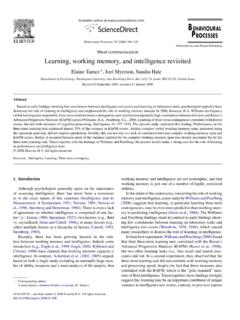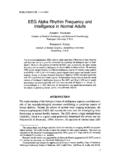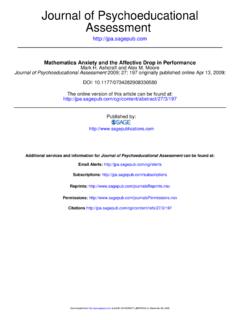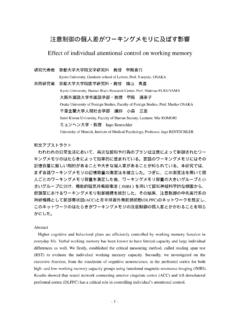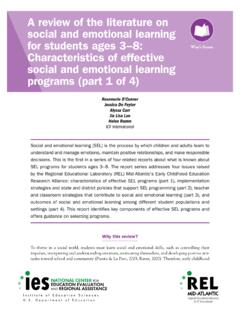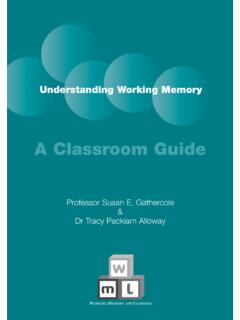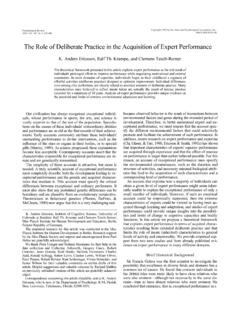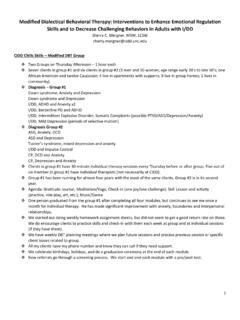Transcription of Working memory capacity and fluid abilities: Examining …
1 Working memory capacity and fluid abilities : Examining thecorrelation between Operation Span and RavenNash Unsworth*, Randall W. EngleSchool of Psychology, 654 Cherry Street, Georgia Institute of Technology, Atlanta, GA 30332-0170, United StatesReceived 23 December 2003; received in revised form 19 August 2004; accepted 26 August 2004 Available online 6 October 2004 AbstractThe correlation between a measure of Working memory capacity (WMC) (Operation Span) and a measureof fluid abilities (Raven Advanced Progressive Matrices) was examined. Specifically, performance on Ravenproblems was decomposed by difficulty, memory load, and rule type. The results suggest that the relationbetween Operation Span and Raven is fairly constant across levels of difficulty, memory load, and rule , it appears something other than the number of things that can be held memory is important for theshared variance between these two tasks.
2 The results are discussed in terms of the importance of attentioncontrol as a possible link between Working memory capacity and fluid Elsevier Inc. All rights :Operation Span; Raven; Working memory capacityA large body of evidence has accumulated over the last decade supporting a substantial relationshipbetween Working memory capacity (WMC) and general fluid intelligence (gF;Ackerman, Beier, &Boyle, 2002; Conway, Cowan, Bunting, Therriault, & Minkoff, 2002; Engle, Tuholski, Laughlin, &Conway, 1999; Kyllonen & Christal, 1990). The exact cause of this relationship, however, remains amystery. The goal of the present study was to better determine the relationship between these twoconstructs by attempting to identify what variables are important for the relationship. In this regard, weutilized a post-hoc decomposition of the Raven Advanced Progressive Matrices (Raven;Raven, Raven,0160-2896/$ - see front matterD2004 Elsevier Inc.)
3 All rights *Corresponding (N. ( Engle).Intelligence 33 (2005) 67 81& Court, 1998) and examined the relation between these decomposed variables with Operation Span(Ospan;Turner & Engle, 1989).1. Working memory capacity and fluid abilitiesAlthough we realize that no task is a pure reflection of the construct of interest, we examinedthe relation between Ospan and Raven for several reasons. Across several studies, the correlationbetween Working memory (WM) span measures, such as reading and counting span, with Raven istypically around (Conway et al., 2002; Engle et al., 1999; Kane et al., 2004). In these samestudies, Ospan tends to correlate with Raven at about ( , 12% shared variance).Furthermore, factor analyses demonstrate that Ospan loads highly on a WM factor and Ravenloads highly on a gF factor, with the path coefficient between the two hovering around (Conway et al.)
4 , 2002; Engle et al., 1999; Kane et al., 2004). Thus, although a moderate first ordercorrelation exists between the two measures, a substantial amount of variance seems to be sharedbetween the two constructs. We hoped to shed light on this shared variance by Examining whatvariables are important for the relationship between putative measures of each construct ( , Ospanand Raven).With this goal in mind, several different research strategies can be used. One strategy is tomanipulate a theoretically important aspect of one of the tasks ( , the difficulty of processing onthe WM span task) and see how that manipulation affects the correlation between the two. Findingthat equating participants on the processing component does not affect the correlation between WMspan and higher-order cognition would suggest that processing efficiency does not account for theshared variance (Conway & Engle, 1996).
5 Another strategy that has become popular in determining the relationship between WMC and gFis the use of CFA and SEM techniques. Here, a set of latent variables are defined by a set of tasksthought to reflect those constructs. After the latent variables are defined, several theoreticallyplausible models are tested to see which model best fits the data. Here, researchers can test the roleof short-term memory in the WM gF relationship (Engle et al., 1999) or test for the possible role ofprocessing speed in the relationship ( ,Ackerman et al., 2002).A third strategy, and the one employed in the current paper, is to examine the simple correlationbetween two tasks by Examining different aspects of performance on one of the tasks and seeing how thecorrelation changes. For instance,Salthouse (1993, Experiment 1)examined the correlation betweeneach item on Raven with both age and (1993)found that the correlation betweensolution accuracy for each problem and a composite measure of WM was fairly constant across allproblems.
6 The same pattern of results held true for the correlations involving age. However, once theWM composite was partialled out of the analysis, the age correlations dropped to near zero. Thesefindings are striking, particularly in light of the fact that Raven problems are arranged systematicallysuch that the easiest items (highest average solution accuracy) are presented first and the most difficultitems (lowest average solution accuracy) are presented last. Based on this evidence, it would seem thatitem variation in terms of difficulty is not a major factor in the WM-Raven correlation. Although,Salthouse (2000)has subsequently found that more difficult items do share some unique variance withage. In this study, Salthouse grouped items into quartiles based on solution accuracy and examined theeffects of each quartile after controlling for the earlier quartiles.
7 Each successive quartile accounted for aN. Unsworth, Engle / Intelligence 33 (2005) 67 8168small, but significant portion of the variance with age. These studies suggest that item variation indifficulty contributes little to individual differences in WMC and age and that some other factor accountsfor most of the ,Carpenter, Just, and Shell (1990)argued that item difficulty is an important aspect ofperformance. These authors performed a thorough item analysis of Raven Progressive Matrices andfound that an item s difficulty level (as evidenced by its error rate) was due to the number of rulebtokensQthat were needed to complete a given problem. Working memory , they argued, is important formaintaining the rule tokens. Specifically, Carpenter et al. argued that the most difficult problems arethose that place a heavy burden on WM resources.
8 A problem that requires two rules, or twoinstantiations of the same rule, should be more difficult than a problem requiring only one rule , based on a classification of the number of rule tokens required for each problem, Carpenter et that the most difficult problems (again, as evidenced by item error rate) also tended to require themost rule tokens. Therefore, the authors suggested that the amount of information that can be maintainedin WM would be an important indicator of reasoning order to test this hypothesis, Carpenter et al. constructed two computer simulation models:FAIRAVEN and BETTERAVEN. The authors suggested that the two models only differed in the factthat BETTERAVEN was better at abstract relations and could hold a larger set of goals in WM. Thesimulations demonstrated that FAIRAVEN could only solve the first half of the test and hence could onlysolve the easiest problems, whereas BETTERAVEN solved nearly all of the problems.
9 Accordingly, theauthors argued thatbOne of the main distinctions between higher scoring subjects and lower scoringsubjects was the ability of the better subjects to successfully generate and manage their problem-solvinggoals in Working memoryQ(p. 428). Based on this, it would seem that what is critical for performance onRaven as well as for the shared variance between Raven and measures of WMC is the number of itemsthat can be held in Working memory . In our first two analyses, we attempt to shed light on thishypothesis by Examining item variations in both difficulty and the number of rule only can item variations in difficulty and the number of relations, or rule tokens, be examined inthis post-hoc manner, but so can other important aspects of performance such as differences in errorpatterns attributable to differences in rule et al.
10 (1990)identified five different ruletypes that are involved in solving Raven problems. The five classified rule types, ordered in terms ofcomplexity, are: (1) constant in a row, in which an aspect of the figure stays the same across a row, butchanges down a column; (2) quantitative pairwise progression, in which there is a quantitative incrementin the figure in adjacent cells; (3) figure addition/subtraction, where parts of the figures are either addedor subtracted from one another; (4) distribution of three, in which three categorical attributes of a figure( , all circles) occur within each row; and (5) distribution of two, just like distribution of three exceptthat only two values are distributed throughout a row. By Examining the error patterns on these differenttypes of rules,Carpenter et al. (1990)found that most subjects made the most errors on problemsinvolving either distribution of three or two rules.
